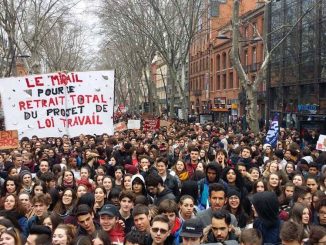Following the death of Supreme Court Justice, Antonin Scalia, on February 13, 2016, the empty Supreme Court seat has become a political battleground between Republicans and Democrats. This has been painted as a decisive struggle for civil rights. But most of the time the Supreme Court does little more than serve the interests of the elite. In cases of civil rights, most often it has ruled against protecting ordinary people. Most times, when the Supreme Court ruled in favor of civil rights, it was only in response to social movements happening in the country.
The Supreme Court upheld the legality of slavery until it was abolished by the U.S. Civil War. In the 1858 Dred Scott case, the Supreme Court ruled against a slave suing for his freedom because the court would not “deprive a slaveholder of his property, such as his slaves,” and that African Americans were “beings of an inferior order…unfit to associate with the white race…and had no rights which the white man was bound to respect.” After the Civil War, when the ruling class in the South imposed policies to terrorize the former slave population, the Supreme Court ruled to protect these racist policies in 1896, leading to the Jim Crow laws.
When it came to the rights of workers, the Supreme Court was almost always on the side of the corporations. During the battles of the working class for union rights, the Supreme Court was used by the corporations to block strikes and attack workers’ organizations, and to defend the ability of the bosses to combat workers’ struggles with the police and the National Guard. In 1919, the Supreme Court was used to uphold the Alien and Sedition Act, which made it illegal to protest the government, and was used to target revolutionary activists across the country, breaking up meetings, destroying offices, imprisoning activists, and deporting many who were immigrants. When this law was used again during World War II to imprison Japanese Americans in concentration camps, the Supreme Court upheld the law then as well.
The Exceptions That Prove the Rule
There are a few exceptions when the Supreme Court ruled in favor of rights for the working class, African Americans and women. But even in these cases, the Supreme Court was responding to the social movements of the time.
During the Great Depression of the 1930s, there were massive working class struggles throughout the country, often shutting down workplaces for multiple days, and sometimes even shutting down whole cities. Workers waged their struggles, taking on the police, the National Guard, and even the army. In response to these struggles, the Roosevelt administration passed a series of laws known as the New Deal in order to give concessions to workers in an effort to curb their struggles. These included legal protection when organizing a union, unemployment compensation, social security and others. Even though the Supreme Court did strike down many parts of the New Deal, they calculated that it was too risky to strike all of them down.
Similarly, in 1954, the Supreme Court ended legalized racial segregation in public schools in the case of “Brown v. Board of Education.” This decision was not made simply because the Supreme Court changed its mind. The Supreme Court made this decision only when a movement was beginning to form once over one million African American soldiers returned from World War II. But afterwards, the Supreme Court did nothing to enforce its decision in the South. It took the continued struggle of millions of African Americans themselves, all over the South and throughout this country, to ultimately force an end to legal segregation.
And in 1973, women won the right to choose to have an abortion. Before then all abortions were illegal except in rare medical emergencies. Thousands of women died every year from abortions with inadequate medical care. Mostly this was the fate of poor women. Rich women could afford better services or to go to countries where abortion was legal. It wasn’t until the late 1960s that a movement for women’s rights grew all over the country, many of whom were veterans of the Civil Rights Movement. Demonstrations and campaigns spread across the U.S. and by 1973, 64 percent of Americans were convinced that abortion should be legal. The Supreme Court decided in the case of “Roe v. Wade” that abortion was a woman’s right up until the last three months of pregnancy. But because the movement ended, the legal protections of the court’s decision eventually began to be eroded, and have been continuously under attack to this day.
And in 2015, the Supreme Court ruled to uphold the right of gay people to get married. But even in this case, the court only came to this 5 to 4 decision after decades of struggle around this issue.
Future Struggles Won’t Be In the Supreme Court
Following the death of Antonin Scalia, we should expect more of the same. The court will mostly uphold the interests of the status quo, the interests of the banks and corporations over the interests of working people. The only people to fight to defend the interests of the working class will be the working class itself. The power to change society is not in the hands of judges and never will be. The power to change society is in the hands of the masses of working people. Our collective action is more powerful than any Supreme Court.




